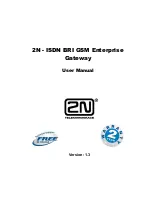
Appendix D Wireless LANs
P-660HN-TxA User’s Guide
298
• Access-Challenge
Sent by a RADIUS server requesting more information in order to allow access.
The access point sends a proper response from the user and then sends another
Access-Request message.
The following types of RADIUS messages are exchanged between the access point
and the RADIUS server for user accounting:
• Accounting-Request
Sent by the access point requesting accounting.
• Accounting-Response
Sent by the RADIUS server to indicate that it has started or stopped accounting.
In order to ensure network security, the access point and the RADIUS server use a
shared secret key, which is a password, they both know. The key is not sent over
the network. In addition to the shared key, password information exchanged is
also encrypted to protect the network from unauthorized access.
Types of EAP Authentication
This section discusses some popular authentication types: EAP-MD5, EAP-TLS,
EAP-TTLS, PEAP and LEAP. Your wireless LAN device may not support all
authentication types.
EAP (Extensible Authentication Protocol) is an authentication protocol that runs on
top of the IEEE 802.1x transport mechanism in order to support multiple types of
user authentication. By using EAP to interact with an EAP-compatible RADIUS
server, an access point helps a wireless station and a RADIUS server perform
authentication.
The type of authentication you use depends on the RADIUS server and an
intermediary AP(s) that supports IEEE 802.1x. .
For EAP-TLS authentication type, you must first have a wired connection to the
network and obtain the certificate(s) from a certificate authority (CA). A certificate
(also called digital IDs) can be used to authenticate users and a CA issues
certificates and guarantees the identity of each certificate owner.
EAP-MD5 (Message-Digest Algorithm 5)
MD5 authentication is the simplest one-way authentication method. The
authentication server sends a challenge to the wireless client. The wireless client
‘proves’ that it knows the password by encrypting the password with the challenge
and sends back the information. Password is not sent in plain text.
Содержание P-660HN-TxA
Страница 2: ......
Страница 8: ...Safety Warnings P 660HN TxA User s Guide 8...
Страница 10: ...Contents Overview P 660HN TxA User s Guide 10...
Страница 18: ...Table of Contents P 660HN TxA User s Guide 18...
Страница 19: ...19 PART I User s Guide...
Страница 20: ...20...
Страница 28: ...Chapter 1 Introduction P 660HN TxA User s Guide 28...
Страница 57: ...57 PART II Technical Reference...
Страница 58: ...58...
Страница 102: ...Chapter 7 LAN Setup P 660HN TxA User s Guide 102...
Страница 150: ...Chapter 9 Network Address Translation NAT P 660HN TxA User s Guide 150...
Страница 154: ...Chapter 10 Firewall P 660HN TxA User s Guide 154...
Страница 164: ...Chapter 12 Static Route P 660HN TxA User s Guide 164...
Страница 190: ...Chapter 16 Remote Management P 660HN TxA User s Guide 190...
Страница 206: ...Chapter 18 CWMP P 660HN TxA User s Guide 206...
Страница 228: ...Chapter 21 Tools P 660HN TxA User s Guide 228...
Страница 238: ...Chapter 23 Troubleshooting P 660HN TxA User s Guide 238...
Страница 270: ...Appendix A Setting up Your Computer s IP Address P 660HN TxA User s Guide 270...
Страница 280: ...Appendix B IP Addresses and Subnetting P 660HN TxA User s Guide 280...
Страница 290: ...Appendix C Pop up Windows JavaScripts and Java Permissions P 660HN TxA User s Guide 290...
Страница 322: ...Index P 660HN TxA User s Guide 322...
Страница 323: ...Index P 660HN TxA User s Guide 323...
Страница 324: ...Index P 660HN TxA User s Guide 324...
















































